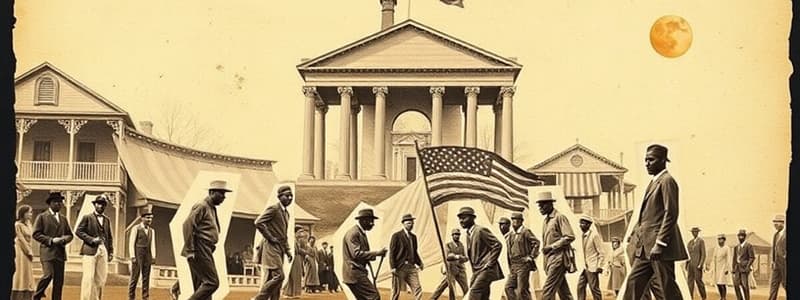Podcast
Questions and Answers
How did the Missouri Compromise address the issue of slavery in the Louisiana Purchase territory, excluding Missouri itself?
How did the Missouri Compromise address the issue of slavery in the Louisiana Purchase territory, excluding Missouri itself?
- It mandated that all new states admitted from the territory would decide the slavery issue via popular sovereignty.
- It designated the entire Louisiana Purchase territory as open to slavery, ensuring economic growth.
- It allowed slavery in the territory for a trial period of ten years, after which a referendum would decide its permanent status.
- It prohibited slavery in the territory north of the 36°30' latitude line. (correct)
What was the primary political objective achieved by admitting both Missouri and Maine into the Union?
What was the primary political objective achieved by admitting both Missouri and Maine into the Union?
- To maintain the balance of power in the Senate between free and slave states. (correct)
- To integrate diverse populations and cultures, promoting national unity and reducing sectionalism.
- To increase the overall number of states, thus enhancing the power of the federal government.
- To satisfy economic demands by creating new markets for both agricultural and industrial products.
What was the long-term effect of the Missouri Compromise on the national debate over slavery?
What was the long-term effect of the Missouri Compromise on the national debate over slavery?
- It permanently resolved the issue of slavery, leading to an era of good feelings and national unity.
- It intensified the debate by highlighting the sectional divide and setting a precedent for future conflicts. (correct)
- It led to the immediate abolition of slavery in all territories west of the Mississippi River.
- It shifted the focus of the debate to economic issues, such as tariffs and internal improvements.
In what way did the 1857 Dred Scott decision impact the Missouri Compromise?
In what way did the 1857 Dred Scott decision impact the Missouri Compromise?
How did the Missouri Compromise contribute to the onset of the Civil War, despite its initial intention?
How did the Missouri Compromise contribute to the onset of the Civil War, despite its initial intention?
Flashcards
Missouri Compromise
Missouri Compromise
An agreement in 1820 to balance free and slave states.
Balance of states (1819)
Balance of states (1819)
In 1819, the US had an equal amount of free and slave states.
Missouri and Maine
Missouri and Maine
Missouri entered as slave; Maine as free, maintaining balance.
36°30' line
36°30' line
Signup and view all the flashcards
Dred Scott Decision
Dred Scott Decision
Signup and view all the flashcards
Study Notes
- The Missouri Compromise was an agreement passed by Congress in 1820.
- The purpose was to resolve the issue of slavery in new territories.
- It was meant to maintain the balance of power between free and slave states in the U.S.
Background
- By 1819, the U.S. had 22 states.
- They were equally divided between free and slave states.
- Missouri, part of the Louisiana Purchase, applied for statehood as a slave state, threatening to disrupt the balance.
Key Provisions
- Missouri was admitted as a slave state.
- Maine, previously part of Massachusetts, was admitted as a free state to maintain the balance.
- Slavery was prohibited in the rest of the Louisiana Purchase territory north of the latitude 36°30', except for Missouri itself.
Political Impact
- It temporarily eased tensions between pro-slavery and anti-slavery factions in Congress.
- The compromise maintained the balance between free and slave states at 12 each.
- It highlighted the growing sectional divide over the issue of slavery, especially as the U.S. expanded westward.
Long-Term Effects
- The compromise only postponed the national conflict over slavery, which would continue to escalate.
- It set a precedent for future debates over slavery in new states and territories.
- The Missouri Compromise was declared unconstitutional in the 1857 Dred Scott decision, further inflaming sectional tensions.
Significance
- It was one of the early attempts to address the divisive issue of slavery and keep the Union together.
- The tensions it sought to resolve would eventually lead to the Civil War.
Studying That Suits You
Use AI to generate personalized quizzes and flashcards to suit your learning preferences.




